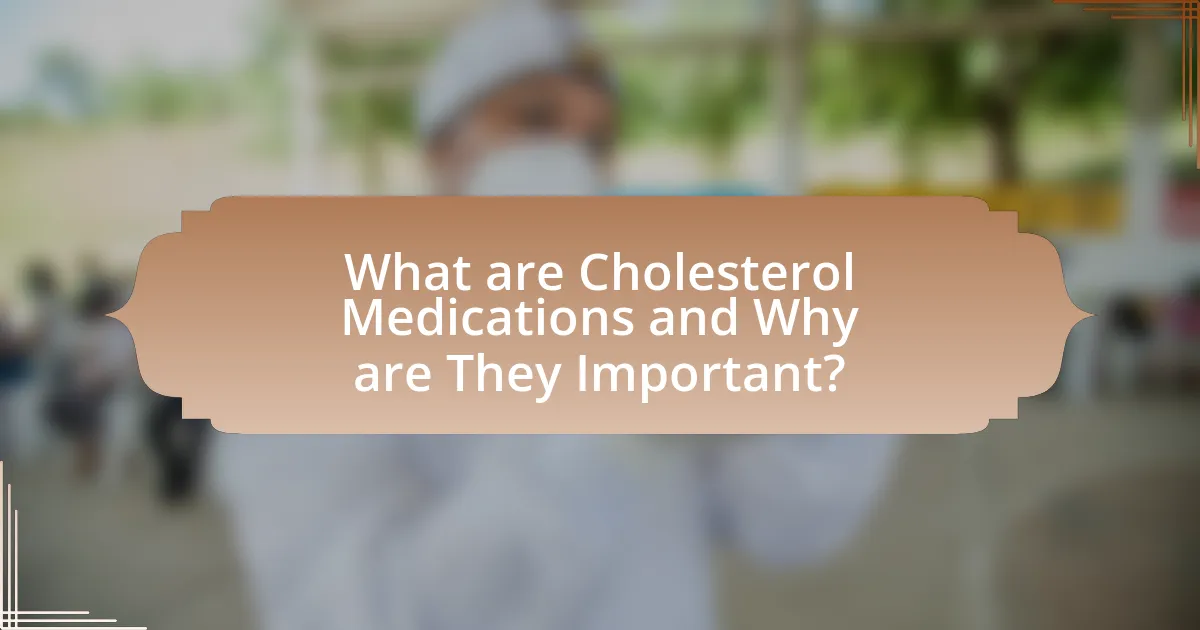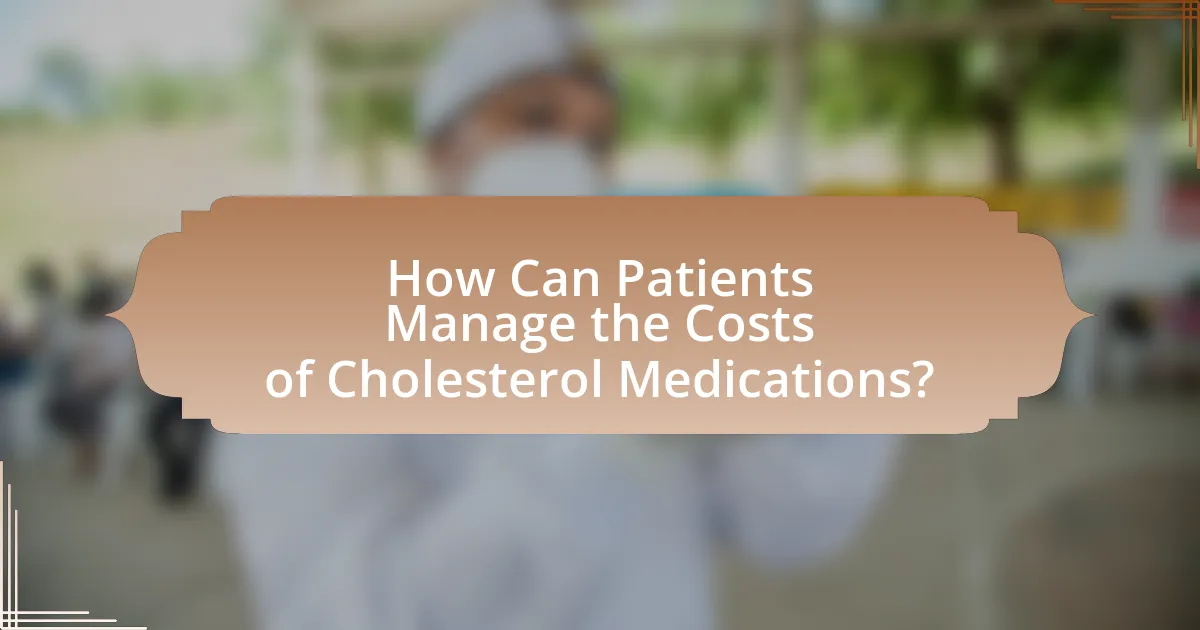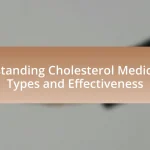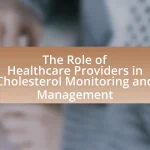Cholesterol medications, particularly statins, play a crucial role in managing high levels of low-density lipoprotein (LDL) cholesterol, which is a significant risk factor for cardiovascular diseases. This article provides an overview of the types of cholesterol medications available, including their mechanisms of action, the importance of managing cholesterol levels, and the associated health risks of high cholesterol. Additionally, it addresses the costs of these medications, factors influencing pricing, and strategies for patients to manage expenses effectively, including the availability of generic options and financial assistance programs. Understanding these aspects is essential for patients to make informed decisions regarding their cholesterol management and overall health.

What are Cholesterol Medications and Why are They Important?
Cholesterol medications, primarily statins, are drugs designed to lower levels of low-density lipoprotein (LDL) cholesterol in the bloodstream. These medications are important because high LDL cholesterol is a significant risk factor for cardiovascular diseases, including heart attacks and strokes. Statins have been shown to reduce the incidence of these events by lowering cholesterol levels, which can lead to improved heart health and longevity. According to a study published in the Journal of the American College of Cardiology, statin therapy can reduce the risk of major cardiovascular events by approximately 25-30% in high-risk individuals.
What types of cholesterol medications are available?
There are several types of cholesterol medications available, including statins, bile acid sequestrants, cholesterol absorption inhibitors, and PCSK9 inhibitors. Statins, such as atorvastatin and simvastatin, are the most commonly prescribed and work by reducing the liver’s production of cholesterol. Bile acid sequestrants, like cholestyramine, help remove cholesterol from the bloodstream by binding to bile acids. Cholesterol absorption inhibitors, such as ezetimibe, decrease the absorption of dietary cholesterol in the intestines. PCSK9 inhibitors, including alirocumab and evolocumab, are newer medications that significantly lower LDL cholesterol levels by enhancing the liver’s ability to remove it from the blood. These medications are supported by clinical guidelines and studies demonstrating their efficacy in managing cholesterol levels and reducing cardiovascular risk.
How do statins work to lower cholesterol levels?
Statins lower cholesterol levels by inhibiting the enzyme HMG-CoA reductase, which plays a crucial role in the production of cholesterol in the liver. This reduction in cholesterol synthesis leads to decreased levels of low-density lipoprotein (LDL) cholesterol, often referred to as “bad” cholesterol, in the bloodstream. Clinical studies have shown that statins can reduce LDL cholesterol levels by 20% to 60%, depending on the specific statin and dosage used. Additionally, statins may enhance the liver’s ability to remove LDL cholesterol from the blood, further contributing to lower cholesterol levels.
What are the differences between statins and non-statin medications?
Statins are a class of medications specifically designed to lower cholesterol levels by inhibiting the enzyme HMG-CoA reductase, which plays a central role in cholesterol synthesis in the liver. In contrast, non-statin medications, such as ezetimibe and PCSK9 inhibitors, utilize different mechanisms to manage cholesterol levels; for example, ezetimibe reduces cholesterol absorption in the intestines, while PCSK9 inhibitors enhance the liver’s ability to remove LDL cholesterol from the bloodstream. Statins are widely prescribed due to their proven efficacy in reducing cardiovascular events, supported by numerous clinical trials, whereas non-statin medications may be used in conjunction with statins or as alternatives for patients who cannot tolerate statins.
Why do patients need cholesterol medications?
Patients need cholesterol medications primarily to manage high cholesterol levels, which can lead to cardiovascular diseases such as heart attacks and strokes. High levels of low-density lipoprotein (LDL) cholesterol are associated with an increased risk of atherosclerosis, a condition where arteries become narrowed and hardened due to plaque buildup. According to the American Heart Association, statins, a common class of cholesterol medications, can reduce the risk of heart disease by 20-30% in individuals with elevated cholesterol levels. Therefore, cholesterol medications are essential for reducing these risks and promoting overall heart health.
What health risks are associated with high cholesterol levels?
High cholesterol levels are associated with significant health risks, primarily cardiovascular diseases. Elevated cholesterol can lead to the buildup of plaques in arteries, increasing the risk of heart attacks and strokes. According to the American Heart Association, individuals with high LDL cholesterol (often referred to as “bad” cholesterol) are at a greater risk for coronary artery disease, which can result in heart failure or sudden cardiac events. Furthermore, high cholesterol can contribute to peripheral artery disease, which affects blood flow to the limbs, and can lead to complications such as gangrene.
How can cholesterol medications improve overall health?
Cholesterol medications can improve overall health by effectively lowering levels of low-density lipoprotein (LDL) cholesterol, which is associated with a reduced risk of cardiovascular diseases. Statins, a common class of cholesterol medications, have been shown to decrease the incidence of heart attacks and strokes by up to 30% in high-risk populations, according to a meta-analysis published in the Journal of the American College of Cardiology. By managing cholesterol levels, these medications help maintain arterial health, reduce inflammation, and improve blood flow, contributing to better heart health and overall well-being.

What is the Cost of Cholesterol Medications?
The cost of cholesterol medications typically ranges from $10 to $300 per month, depending on the specific medication and insurance coverage. Statins, the most commonly prescribed cholesterol-lowering drugs, can cost between $10 and $50 for generic versions, while brand-name options may exceed $200. According to a 2021 report from the American Heart Association, nearly 50% of patients do not adhere to their prescribed cholesterol medication due to cost concerns, highlighting the financial burden these medications can impose.
How much do cholesterol medications typically cost?
Cholesterol medications typically cost between $10 to $300 per month, depending on the specific medication and whether a generic version is available. For example, statins, which are commonly prescribed, can range from $10 for generic versions to over $200 for brand-name options. According to a 2021 report from the American Heart Association, the average out-of-pocket cost for patients can vary significantly based on insurance coverage and pharmacy pricing.
What factors influence the price of cholesterol medications?
The price of cholesterol medications is influenced by several key factors, including manufacturing costs, patent status, market competition, and insurance coverage. Manufacturing costs encompass the expenses related to raw materials, production processes, and quality control, which directly affect the final price. Patent status plays a significant role, as brand-name medications protected by patents tend to be more expensive due to lack of generic alternatives. Market competition impacts pricing as well; when multiple manufacturers produce similar medications, prices often decrease. Lastly, insurance coverage can significantly alter out-of-pocket costs for patients, as different plans may cover various medications at different rates, affecting overall affordability.
Are there generic options available for cholesterol medications?
Yes, there are generic options available for cholesterol medications. Many commonly prescribed cholesterol-lowering drugs, such as statins, have generic versions that are often more affordable than their brand-name counterparts. For instance, atorvastatin, simvastatin, and rosuvastatin are widely available in generic forms, which can significantly reduce costs for patients. According to the FDA, generic medications must meet the same quality and efficacy standards as brand-name drugs, ensuring that patients receive effective treatment at a lower price.
What are the potential out-of-pocket expenses for patients?
Potential out-of-pocket expenses for patients include copayments, deductibles, and coinsurance associated with cholesterol medications. For instance, patients may face copayments ranging from $10 to $50 per prescription, depending on their insurance plan. Additionally, if a patient has not met their deductible, they may need to pay the full price of the medication until that threshold is reached, which can be several hundred dollars. Coinsurance, which is a percentage of the medication cost that the patient must pay, can also contribute to out-of-pocket expenses, often ranging from 10% to 30%. These costs can vary significantly based on the specific medication prescribed, the patient’s insurance coverage, and the pharmacy used for filling prescriptions.
How do insurance plans affect the cost of cholesterol medications?
Insurance plans significantly influence the cost of cholesterol medications by determining coverage levels, copay amounts, and formulary placement. For instance, medications classified as preferred on a formulary typically incur lower out-of-pocket costs for patients, while non-preferred drugs may result in higher copays or may not be covered at all. According to a study published in the Journal of Managed Care & Specialty Pharmacy, patients with insurance plans that have comprehensive coverage for statins, a common class of cholesterol medications, experience lower overall costs compared to those with high-deductible plans or limited formularies. This demonstrates that the structure of an insurance plan directly impacts the affordability of cholesterol medications for patients.
What financial assistance programs are available for patients?
Financial assistance programs available for patients include pharmaceutical company patient assistance programs, government-funded programs like Medicaid and Medicare, and non-profit organizations that provide grants or subsidies. Pharmaceutical companies often offer programs to help low-income patients access medications at reduced costs or for free, with eligibility typically based on income and insurance status. Medicaid and Medicare provide coverage for eligible individuals, helping to offset medication costs. Non-profit organizations, such as the Patient Advocate Foundation, offer financial assistance and resources to help patients manage their healthcare expenses. These programs are designed to alleviate the financial burden of medications, particularly for those with chronic conditions like high cholesterol.

How Can Patients Manage the Costs of Cholesterol Medications?
Patients can manage the costs of cholesterol medications by exploring generic alternatives, utilizing patient assistance programs, and discussing cost-effective options with their healthcare providers. Generic medications often provide the same therapeutic benefits as brand-name drugs at a significantly lower price, making them a viable option for many patients. Additionally, pharmaceutical companies and non-profit organizations frequently offer patient assistance programs that can help cover medication costs for eligible individuals. Engaging in open conversations with healthcare providers can lead to the identification of lower-cost medications or alternative treatment plans that align with a patient’s financial situation.
What strategies can patients use to reduce medication costs?
Patients can reduce medication costs by utilizing generic medications, seeking patient assistance programs, and comparing prices at different pharmacies. Generic medications are often significantly cheaper than their brand-name counterparts, providing the same therapeutic benefits. Patient assistance programs, offered by pharmaceutical companies and non-profits, can provide medications at reduced costs or even for free to eligible individuals. Additionally, patients can use online tools and apps to compare prices across various pharmacies, which can lead to substantial savings, as prices can vary widely for the same medication.
How can patients effectively communicate with their healthcare providers about costs?
Patients can effectively communicate with their healthcare providers about costs by preparing specific questions regarding medication prices, insurance coverage, and potential out-of-pocket expenses before their appointments. This proactive approach allows patients to clarify financial concerns and explore alternatives, such as generic options or patient assistance programs. Research indicates that clear communication about costs can lead to better treatment adherence and satisfaction, as patients who understand their financial responsibilities are more likely to follow prescribed regimens.
What role do pharmacy discount programs play in managing costs?
Pharmacy discount programs significantly reduce the out-of-pocket expenses for patients, making medications more affordable. These programs often provide discounts on prescription drugs, including cholesterol medications, which can help patients manage their healthcare costs effectively. For instance, a study by the Kaiser Family Foundation found that nearly 30% of Americans reported using a discount card or coupon to lower their prescription costs, demonstrating the widespread impact of these programs on financial accessibility.
What are some common misconceptions about cholesterol medication costs?
Common misconceptions about cholesterol medication costs include the belief that all cholesterol medications are prohibitively expensive and that insurance always covers these costs. In reality, many generic options exist that are significantly cheaper, often costing less than $10 per month. Additionally, while insurance plans vary, many do provide coverage for cholesterol medications, which can reduce out-of-pocket expenses. According to a report from the American Heart Association, nearly 70% of patients with high cholesterol are prescribed statins, and many of these prescriptions are available at low costs due to generics.
Why do some patients believe cholesterol medications are unaffordable?
Some patients believe cholesterol medications are unaffordable due to high out-of-pocket costs and lack of insurance coverage. According to a 2021 survey by the Kaiser Family Foundation, nearly 30% of Americans reported that they or a family member had difficulty affording prescription medications, with cholesterol drugs often being among the most expensive. Additionally, the price of brand-name statins can exceed $500 per month without insurance, leading to financial strain for many patients.
How can understanding medication pricing help patients make informed decisions?
Understanding medication pricing enables patients to make informed decisions by allowing them to compare costs, assess affordability, and choose the most effective treatment options. When patients are aware of the prices of cholesterol medications, they can evaluate their insurance coverage, identify potential out-of-pocket expenses, and explore generic alternatives that may be more cost-effective. Research indicates that patients who actively engage in understanding medication costs are more likely to adhere to their prescribed treatments, ultimately leading to better health outcomes. For instance, a study published in the Journal of Managed Care & Specialty Pharmacy found that price transparency significantly improved medication adherence among patients with chronic conditions.
What practical tips can help patients navigate cholesterol medication costs?
Patients can navigate cholesterol medication costs by exploring generic alternatives, utilizing patient assistance programs, and discussing cost concerns with their healthcare providers. Generic medications often provide the same therapeutic benefits as brand-name drugs at a significantly lower price, making them a cost-effective option. Many pharmaceutical companies offer patient assistance programs that can help eligible patients access medications at reduced costs or even for free. Additionally, open communication with healthcare providers can lead to tailored treatment plans that consider both efficacy and affordability, ensuring patients receive the necessary medications without financial strain.










